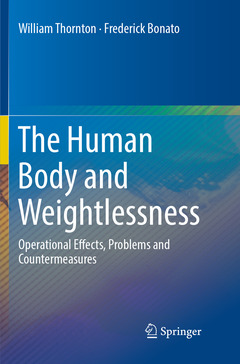Description
The Human Body and Weightlessness, Softcover reprint of the original 1st ed. 2017
Operational Effects, Problems and Countermeasures
Authors: Thornton William, Bonato Frederick
Language: English
Subjects for The Human Body and Weightlessness:
189.89 €
In Print (Delivery period: 15 days).
Add to cartPublication date: 09-2018
Support: Print on demand
189.89 €
In Print (Delivery period: 15 days).
Add to cartPublication date: 10-2017
Support: Print on demand
Description
/li>Contents
/li>Biography
/li>Comment
/li>
This book focuses on all of the major problems associated with the absence of body weight in space, by analyzing effects, adaption, and re-adaptation upon returning to Earth, using sound scientific principles embedded in a historical context. Serious problems for space travelers range from Space Motion Sickness (SMS) to recently discovered ocular effects that may permanently impair vision. Fluid loss and shifts, spinal changes, and bone and muscle loss are also all results of weightlessness.
Starting with a brief definition and history of weightlessness, the authors then address in detail each problem as well as the countermeasures aimed at alleviating them. In some cases, alternative hypotheses regarding what can and should be attempted are also presented. As plans for long-term missions to the Moon and Mars develop, it will be essential to find countermeasures to weightlessness that are effective for missions that could span years.
Dr. William Thornton has unparalleled experience in research, development and application of medical instrumentation and equipment, especially in human spaceflight. He also taught physical diagnosis and developed widely used computer-based multimedia programs and accompanying text in academic clinical medicine. His education includes physics, medicine, flight medicine, USAF flight school, (2000 plus hours as pilot of supersonic jets) and NASA astronaut training (two flights on Space shuttle).
In addition to unique and successful research and development in military programs and clinical medicine, Dr. Thornton has worked on problems of human spaceflight in the USAF space program and served for 27 years as a NASA astronaut, working on all programs from Apollo to ISS. Dr. Thornton has been Principal Investigator on over 20 inflight investigations. He was the flight surgeon in an unprecedented 54-day closed chamber low pressure test of equipment and procedures (SMEAT) for the Skylab missions. His findings produced redesign and replacement of several key items prior to that mission.
Dr. Thornton is the veteran of two Shuttle flights (STS-8 and STS-51B). He is the only person to date who has designed and flown with his own lab and protocol (STS-8) and was in charge of the first animal flight (STS-51B). His firsts include monitoring by telemetry surgical and ambulatory patients, automated EKG analysis, mass measurement devices for space, measurements in space demonstrating fluid shift and loss, measurements of loss of muscle and strength in space and means of prevention by exercise and diet, development of the Shuttle treadmill, rowing machine, waste collection system (toilet) and others. Thornton holds 50 patents in military aviation, clinical medicine and space biophysics.
Dr. Bonato has published widely on aerospace medical topics such as motion sickness, space motion sickness (with Dr. Thornton), simulator sickness, cybersickn




